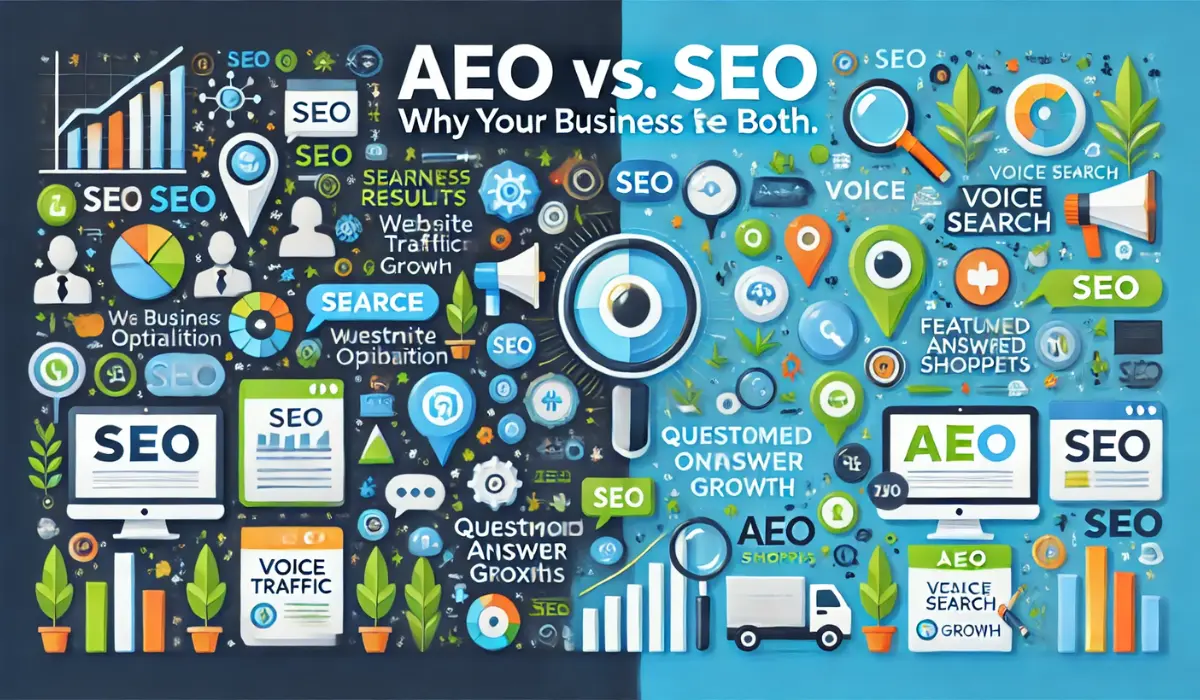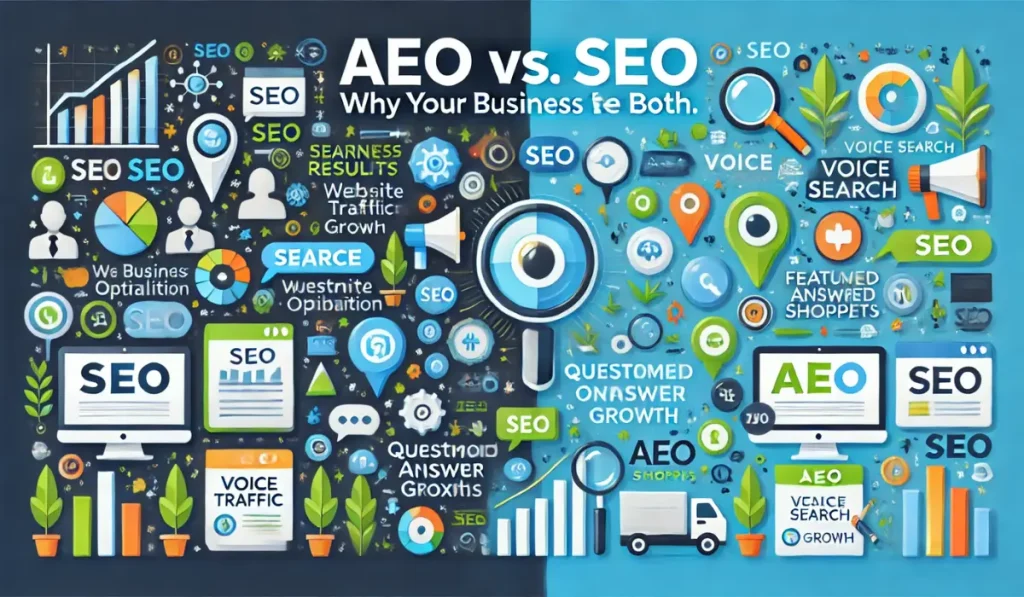In the fast-evolving digital marketing landscape, businesses often focus on improving visibility in search engines to attract more customers. Traditionally, Search Engine Optimization (SEO) has been the primary strategy for optimizing website rankings on search engine result pages (SERPs). However, as digital experiences continue to shift, another form of optimization has emerged: Answer Engine Optimization (AEO).
So, what exactly is AEO? How does it differ from SEO, and why is it important to consider both for your business? In this article, we’ll dive into the details of AEO vs. SEO, how each contributes to your online visibility, and why they are most powerful when used together.
What is SEO?
SEO (Search Engine Optimization) is the process of optimizing a website to increase its chances of ranking higher on search engine results pages. This process involves a variety of tactics, including:
- Keyword Optimization: Identifying the keywords people use in searches and incorporating them strategically into content.
- On-Page Optimization: Ensuring website content, headings, meta descriptions, and images are optimized for search engines.
- Technical SEO: Enhancing website structure, speed, mobile-friendliness, and security (HTTPS) to make the site more accessible to search engines.
- Backlinking: Acquiring high-quality links from other reputable sites to boost credibility and authority.
- Content Marketing: Creating valuable content that addresses user intent and generates engagement.
SEO has been foundational for digital marketing for over two decades, helping businesses increase organic traffic and improve their visibility. The goal is to appear on the first page of SERPs for relevant search queries and, ideally, rank in the top three results to attract more clicks.
What is AEO?
AEO (Answer Engine Optimization) is an evolution of SEO that focuses specifically on optimizing content to answer user queries directly. This approach is designed to improve a business’s chances of appearing in featured snippets, voice search results, and other “answer boxes” that deliver concise, specific answers to users.
With the rise of voice assistants like Siri, Google Assistant, and Alexa, users increasingly look for answers rather than browsing through a list of links. AEO aims to meet this demand by providing the most relevant and direct responses.
Key elements of AEO include:
- Structured Data Markup: Using schema markup to help search engines understand the content and context of your page.
- Answer-Driven Content: Creating content that directly answers frequently asked questions, typically in concise and clear formats.
- Optimizing for Voice Search: Many voice searches are phrased as questions; AEO focuses on optimizing for “question-based” keywords.
- Emphasis on Featured Snippets: Crafting content that is easily extracted and displayed as a snippet on Google’s search results page.
AEO vs. SEO: Key Differences
| Feature | SEO | AEO |
| Goal | Improve rankings on SERPs | Provide direct answers for quick user queries |
| Primary Focus | Keywords, backlinks, on-page & technical optimization | Answer-driven content, structured data, voice search |
| Preferred Device | Desktop and mobile browsers | Mobile devices, smart speakers, and voice assistants |
| Content Style | Long-form, keyword-optimized | Concise, question-based |
| Metrics of Success | Organic traffic, CTR, bounce rate | Featured snippet appearance, voice search results |
Why Your Business Needs Both AEO and SEO
SEO and AEO serve different aspects of digital engagement. While SEO drives organic traffic to your website by helping it rank higher on traditional SERPs, AEO enables you to reach audiences who want instant, specific answers. Here’s why combining both can create a competitive edge:
1. Maximizes Visibility Across Different Platforms
- SEO helps you capture traffic from users who search in traditional formats, particularly on desktops and mobile devices.
- AEO allows your brand to appear in quick-answer formats, which are ideal for voice searches and mobile users who prefer on-the-go responses.
- Together, these approaches ensure your business is visible across a broader range of devices and search contexts.
2. Increases Your Chances of Gaining Featured Snippets
- Featured snippets are highly coveted spots because they appear above traditional organic results (known as “Position Zero”).
- AEO directly targets featured snippets by focusing on answering questions concisely, but SEO builds the authority and relevance needed to be considered for these spots.
- A blend of SEO and AEO strategies maximizes your chances of obtaining these valuable positions.
3. Prepares for the Future of Search
- As voice search grows, the importance of answer-focused content will only increase. Many analysts predict that the next wave of search will be conversational and based on AI interactions.
- By investing in AEO now, your business is well-positioned for the future, ready to serve customers who will increasingly expect immediate answers through voice and smart devices.
4. Improves Customer Experience
- Users appreciate concise answers for specific questions but also value the option to learn more if needed.
- SEO drives users to your site where they can explore in-depth content, while AEO satisfies those looking for quick solutions.
- Together, these approaches create a positive experience by catering to both in-depth and quick-answer search preferences.
5. Broadens Your Customer Reach
- Different audiences use different search styles. Some users type detailed queries in search engines, while others use short, voice-activated questions on mobile.
- By incorporating both SEO and AEO, you can reach both types of users and cater to diverse search preferences.
Also Read

Implementing AEO and SEO: Key Tips for Success
To make the most of AEO and SEO, consider these strategies:
- Optimize for Long-Tail Keywords and Questions: Identify long-tail keywords and commonly asked questions related to your business. These can serve both AEO and SEO by helping your content rank for traditional searches and voice-based queries.
- Use Structured Data Markup: Adding schema markup helps search engines understand your content better, increasing the likelihood of being featured in snippets or answer boxes.
- Create FAQ Pages: An FAQ section on your site is great for AEO as it provides answers to common questions, and it supports SEO by improving on-page engagement and keeping visitors on your site.
- Focus on Local SEO and AEO: If you’re a local business, optimizing for local search results (Google My Business, local keywords, etc.) is essential. Voice search, in particular, is often used for local inquiries, such as “near me” searches.
- Optimize for Mobile: AEO is particularly relevant for mobile users, so ensuring your site is mobile-friendly will support both AEO and SEO efforts.
Final Thoughts: AEO and SEO Together are a Win-Win
As search behavior continues to evolve, the lines between SEO and AEO will likely blur, but the core goals remain the same: delivering the best, most relevant content to users. By leveraging both SEO and AEO, businesses can build a robust digital strategy that not only ranks high in traditional searches but also meets the needs of users looking for immediate answers. In summary, SEO is essential for organic traffic and long-term authority, while AEO caters to immediate, answer-focused queries—especially on voice-activated platforms. When used together, SEO and AEO complement each other, providing a comprehensive strategy that maximizes visibility, enhances user experience, and ultimately drives growth.




